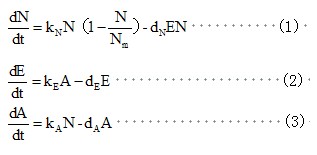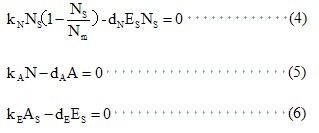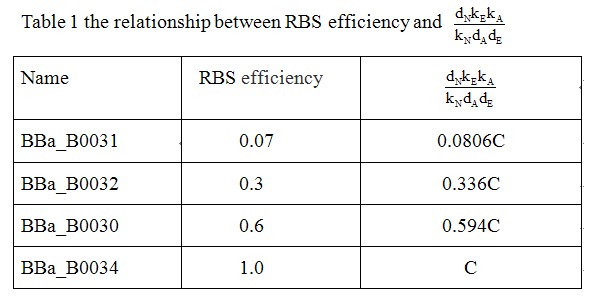Team:XMU-China/Model
From 2011.igem.org
(Difference between revisions)
(Created page with "Different RBS sequences leads to different levels of expression of the killer protein CcdB which is directly linked to the effects of our programmed cell-death circuit. So we con...") |
(→reference) |
||
| (9 intermediate revisions not shown) | |||
| Line 1: | Line 1: | ||
| - | Different RBS sequences | + | {{:Team:XMU-China/Hidden}} |
| + | {{:Team:XMU-China/List}} | ||
| + | |||
| + | Different RBS sequences lead to different levels of expression of the killer protein ccdB which is directly linked to the effects of our programmed cell-death circuit. So we constructed a series of circuits with different RBS sequences so as to detect how RBS of different efficiency can affect the viable cell density at steady state. We build a model to search for a theory to predict growth rule of bacteria with the programmed cell-death circuit. | ||
| + | |||
We assume that:(1) without the circuit,changes in viable cell density(N,/ml)follow logistic kinetics;(2)for population-circuit growth, the cell death rate is proportional to the intracellular concentration of the kill protein(E, nM) ;(3)the production rate of E is proportional to AHL concentration(A, nM) ; (4)AHL production rate is proportional to N;(5)degradation of the kill protein and AHL follows first-order kinetics. | We assume that:(1) without the circuit,changes in viable cell density(N,/ml)follow logistic kinetics;(2)for population-circuit growth, the cell death rate is proportional to the intracellular concentration of the kill protein(E, nM) ;(3)the production rate of E is proportional to AHL concentration(A, nM) ; (4)AHL production rate is proportional to N;(5)degradation of the kill protein and AHL follows first-order kinetics. | ||
| - | + | [[Image:XMU_China_124.jpg|left]] | |
| + | <html> | ||
| + | <img src="http://partsregistry.org/wiki/images/4/41/XMU_China_block.jpg"> | ||
| + | </html> | ||
| - | |||
| - | + | ||
| + | |||
| + | [[Image:XMU_China_125.jpg|left]] | ||
| + | |||
| + | |||
| + | |||
| + | are the rate constants(/h). | ||
| + | |||
| + | |||
| + | <html> | ||
| + | <img src="http://partsregistry.org/wiki/images/4/41/XMU_China_block.jpg"> | ||
| + | </html> | ||
| + | |||
| + | |||
| + | |||
| + | [[Image:XMU_China_126.jpg|left]] | ||
| + | |||
| + | |||
| + | |||
| + | is the carrying capacity in the Limited medium without the cell-death circuit. | ||
At steady state, we can get the following equations: | At steady state, we can get the following equations: | ||
| - | + | [[Image:XMU_China_127.jpg|left]] | |
| + | |||
| + | |||
| + | <html> | ||
| + | <img src="http://partsregistry.org/wiki/images/4/41/XMU_China_block.jpg"> | ||
| + | </html> | ||
| + | |||
| + | |||
Where subscript ‘s’ represents steady state. | Where subscript ‘s’ represents steady state. | ||
There are two steady-state solutions: | There are two steady-state solutions: | ||
| - | + | [[Image:XMU_China_128.jpg|left]] | |
| + | |||
| + | <html> | ||
| + | <img src="http://partsregistry.org/wiki/images/4/41/XMU_China_block.jpg"> | ||
| + | </html> | ||
| + | |||
| + | |||
We can get the following equation (9) from equation (8) . | We can get the following equation (9) from equation (8) . | ||
| - | + | [[Image:XMU_China_129.jpg|left]] | |
| + | |||
| + | |||
| + | <html> | ||
| + | <img src="http://partsregistry.org/wiki/images/4/41/XMU_China_block.jpg"> | ||
| + | </html> | ||
| + | |||
| + | |||
With time limited, we only conducted the experiment on the viable cell density at steady-state with the population-control device with RBS0.07 ,RBS0.3, RBS0.6 and RBS1.0. | With time limited, we only conducted the experiment on the viable cell density at steady-state with the population-control device with RBS0.07 ,RBS0.3, RBS0.6 and RBS1.0. | ||
| - | And we define that: | + | And we define that:[[Image:XMU_China_130.jpg|left]] |
| + | |||
| + | |||
| + | <html> | ||
| + | <img src="http://partsregistry.org/wiki/images/4/41/XMU_China_block.jpg"> | ||
| + | </html> | ||
| + | |||
| + | |||
Computed from our experimental data, we can get the data listed in Table 1. | Computed from our experimental data, we can get the data listed in Table 1. | ||
| - | + | [[Image:XMU_China_131.jpg|left]] | |
| + | |||
| + | |||
| + | <html> | ||
| + | <img src="http://partsregistry.org/wiki/images/4/41/XMU_China_block.jpg"> | ||
| + | </html> | ||
| + | |||
| + | |||
From the model and Table 1, we can conclude that: the efficiency of RBS (a) may have close relationship with kE . Based on the device of RBS1.0, the viable cell density at steady-state (NS ) of other devices with different efficiency of RBS can be shown as equation(10). | From the model and Table 1, we can conclude that: the efficiency of RBS (a) may have close relationship with kE . Based on the device of RBS1.0, the viable cell density at steady-state (NS ) of other devices with different efficiency of RBS can be shown as equation(10). | ||
| - | + | [[Image:XMU_China_132.jpg|left]] | |
| + | |||
| + | |||
| + | <html> | ||
| + | <img src="http://partsregistry.org/wiki/images/4/41/XMU_China_block.jpg"> | ||
| + | </html> | ||
| + | |||
| + | |||
C is -4.96322E-09 in our experiment. | C is -4.96322E-09 in our experiment. | ||
| + | |||
| + | ==reference== | ||
| + | |||
| + | [1]You L, Cox RS, Weiss R, Arnold FH. Programmed population control by cell-cell communication and regulated killing[J]. Nature, 2004, 428(6985): 868-871. | ||
Latest revision as of 12:07, 28 October 2011
 "
"








